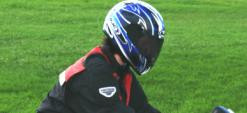Wearing a motorcycle helmet is non-negotiable for safety, and choosing the right one is crucial for both protection and comfort. Among the myriad of options available, DOT motorcycle helmets stand out as a benchmark for safety in the United States. This guide will walk you through everything you need to know to select a DOT-approved helmet that fits perfectly and keeps you safe on every ride.
Finding the Perfect Fit: Shape and Size Matter
Just like shoes, motorcycle helmets aren’t one-size-fits-all. Head shape and size are fundamental to finding a helmet that not only feels comfortable but also provides optimal protection in the event of an accident.
Understanding Your Head Shape
Helmets are manufactured in different interior shapes to accommodate the variations in human head forms. The primary shapes are:
- Round Oval: Heads that are wider and rounder.
- Intermediate Oval: The most common head shape, slightly longer than wide.
- Long Oval: Heads that are significantly longer than they are wide.
Determining your head shape is the first step to a comfortable and safe fit. You can easily assess your head shape using a mirror or with the help of a friend looking down at the top of your head. Focus on the shape of your skull, not just your face.
Identifying Pressure Points
When trying on a helmet, pay close attention to any pressure points. A helmet that feels tight on your forehead but loose on the sides might be too round for your head shape. Conversely, pressure on the temples and looseness at the forehead suggests a helmet that’s too oval. It’s essential to wear a new helmet for 30 to 45 minutes indoors before your first ride to identify any developing pressure points that might become painful over longer rides.
Measuring for the Right Size
Accurate head measurement is vital for selecting the correct helmet size. Use a flexible cloth measuring tape to measure the circumference of your head. Position the tape just above your eyebrows and encircle the widest part of the back of your head. Compare this measurement against the manufacturer’s size chart.
A properly sized DOT motorcycle helmet should feel snug, applying even pressure around your head without any distinct pressure points. It should not move excessively when you shake your head from side to side. A helmet that’s too loose can be dangerous as it may not stay in position during a crash.
Adjusting for a Custom Fit
Many DOT helmet manufacturers offer customization options like interchangeable cheek pads and liners. These allow for fine-tuning the internal fit and shape of the helmet. While these adjustments are acceptable, avoid making any other alterations to the helmet’s interior, as this could void the warranty and compromise its structural integrity. Your helmet should fit snugly around the crown of your head and firmly against your cheeks.
Exploring DOT Helmet Styles for Every Rider
 A motorcyclist wearing a full-face DOT approved helmet
A motorcyclist wearing a full-face DOT approved helmet
DOT motorcycle helmets come in various styles, each designed with specific features to suit different riding preferences, motorcycle types, and safety needs.
Full-Face Helmets
Full-face DOT motorcycle helmets are the gold standard for comprehensive protection. They offer:
- Superior aerodynamic performance, reducing wind resistance and noise.
- Enhanced comfort for long rides.
- Effective ventilation systems to keep you cool.
Modular Helmets
Modular DOT helmets provide versatility, functioning as both full-face and open-face helmets. They are popular among:
- Adventure and dual-sport riders who need flexibility.
- Riders who appreciate the convenience of easily switching between full and open face configurations.
- Offering good airflow while protecting against dust and debris.
Dual-Sport Helmets
Dual-sport DOT helmets bridge the gap between off-road and street riding.
- Traditional designs feature extended chin bars and visors, typically requiring goggles.
- Modern versions often include integrated face shields for added convenience.
- Excellent for diverse riding conditions and both on and off-road adventures.
Off-Road Helmets
Off-road DOT helmets are specifically engineered for rugged terrains and activities like motocross.
- Characterized by pronounced chin bars and visors, designed for use with goggles.
- Maximize airflow, crucial for strenuous off-road riding.
- Ideal for motocross, enduro, and other off-road disciplines.
High-Visibility (Hi-Viz) Helmets
Hi-viz DOT motorcycle helmets prioritize rider visibility.
- Significantly increase your chances of being seen by other motorists, especially in low-light conditions.
- Available across various helmet styles, offering an extra layer of safety.
- A smart choice for daily commuters and riders concerned about visibility.
Half and Open-Face Helmets: Limited Protection
Half helmets and open-face DOT helmets offer minimal coverage.
- Provide a lower level of protection compared to full-face options.
- Lack chin guards, leaving the face and chin vulnerable in a crash.
- Known for significant wind noise, which can be tiring on longer rides.
Verifying DOT Safety Ratings: Look for the Symbol
Ensuring your helmet meets safety standards is paramount. DOT motorcycle helmets sold in the U.S. must comply with the Federal Motor Vehicle Safety Standard (FMVSS) No. 218.
The DOT symbol on the helmet’s back exterior is your assurance of compliance. While NHTSA doesn’t “approve” helmets, they conduct rigorous testing to ensure adherence to FMVSS No. 218. Helmets that fail these tests can be recalled, highlighting NHTSA’s active role in monitoring helmet safety. You can find information on helmets that have been tested on the NHTSA online database.
DOT-compliant helmets feature a label on the back containing:
- Manufacturer and/or brand name
- Model designation
- “DOT” symbol
- FMVSS No. 218 certification
- “CERTIFIED” wording
Helmets certified before May 13, 2013, may only display “DOT.”
Recognizing and Avoiding Unsafe Helmets
Despite regulations, “novelty helmets” that don’t meet DOT standards are still sold. These and counterfeit DOT labels pose a serious risk.
Novelty helmets offer virtually no protection in a crash and should never be used. Here’s how to identify unsafe helmets:
Red Flags for Unsafe Helmets
- Thin Shell and Liner: Unsafe helmets are often less than 1 inch thick and lack a rigid foam inner liner.
- Poor Quality Straps: DOT-compliant helmets have sturdy chin straps with solid rivets, while unsafe helmets may have flimsy plastic buckles.
- Light Weight: Helmets meeting DOT standards typically weigh around 3 pounds. Be wary of helmets advertised as “lightest weight” or weighing a pound or less.
- Protruding Decorations: FMVSS No. 218 limits protrusions to two-tenths of an inch. Rigid spikes or large decorations are indicators of unsafe helmets.
- “German Army” or “Skullcap” Styles: While some German Army style helmets may be DOT compliant, these styles are often associated with unsafe novelty helmets due to their minimal coverage and size. Unsafe versions are noticeably smaller and thinner than DOT-approved helmets.
Stay Informed and Ride Safe
Choosing a DOT motorcycle helmet is a critical step in ensuring your safety on the road. By understanding helmet fit, style options, and how to verify DOT certification, you can make informed decisions. Always prioritize DOT-approved helmets and be vigilant about identifying and avoiding unsafe novelty helmets. Safe riding involves preparation, sound judgment, and the right gear – starting with a reliable DOT helmet.
For more information on motorcycle safety, visit Motorcycle Safety at NHTSA.

